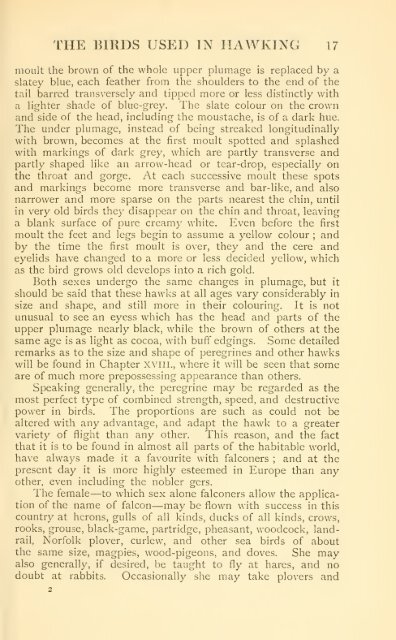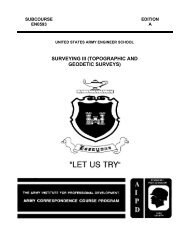The art and practice of hawking - Modern Prepper
The art and practice of hawking - Modern Prepper
The art and practice of hawking - Modern Prepper
- No tags were found...
Create successful ePaper yourself
Turn your PDF publications into a flip-book with our unique Google optimized e-Paper software.
THE BIRDS USED IN HAWKING 17<br />
moult the brown <strong>of</strong> the whole upper plumage is replaced by a<br />
slatey blue, each feather from the shoulders to the end <strong>of</strong> the<br />
tail barred transversely <strong>and</strong> tipped more or less distinctly with<br />
a lighter shade <strong>of</strong> blue-grey. <strong>The</strong> slate colour on the crown<br />
<strong>and</strong> side <strong>of</strong> the head, including the moustache, is <strong>of</strong> a dark hue.<br />
<strong>The</strong> under plumage, instead <strong>of</strong> being streaked longitudinally<br />
with brown, becomes at the first moult spotted <strong>and</strong> splashed<br />
with markings <strong>of</strong> dark grey, which are p<strong>art</strong>ly transverse <strong>and</strong><br />
p<strong>art</strong>ly shaped like an arrow-head or tear-drop, especially on<br />
the throat <strong>and</strong> gorge. At each successive moult these spots<br />
<strong>and</strong> markings become more transverse <strong>and</strong> bar-like, <strong>and</strong> also<br />
narrower <strong>and</strong> more sparse on the p<strong>art</strong>s nearest the chin, until<br />
in very old birds they disappear on the chin <strong>and</strong> throat, leaving<br />
a blank surface <strong>of</strong> pure creamy white. Even before the first<br />
moult the feet <strong>and</strong> legs begin to assume a yellow colour ;<br />
<strong>and</strong><br />
by the time the first moult is over, they <strong>and</strong> the cere <strong>and</strong><br />
eyelids have changed to a more or less decided yellow, which<br />
as the bird grows old develops into a rich gold.<br />
Both sexes undergo the same changes in plumage, but it<br />
should be said that these hawks at all ages vary considerably in<br />
size <strong>and</strong> shape, <strong>and</strong> still more in their colouring. It is not<br />
unusual to see an eyess which has the head <strong>and</strong> p<strong>art</strong>s <strong>of</strong> the<br />
upper plumage nearly black, while the brown <strong>of</strong> others at the<br />
same age is as light as cocoa, with buff edgings. Some detailed<br />
remarks as to the size <strong>and</strong> shape <strong>of</strong> peregrines <strong>and</strong> other hawks<br />
will be found in Chapter xviil., where it will be seen that some<br />
are <strong>of</strong> much more prepossessing appearance than others.<br />
Speaking generally, the peregrine may be regarded as the<br />
most perfect type <strong>of</strong> combined strength, speed, <strong>and</strong> destructive<br />
power in birds. <strong>The</strong> proportions are such as could not be<br />
altered with any advantage, <strong>and</strong> adapt the hawk to a greater<br />
variety <strong>of</strong> flight than any other. This reason, <strong>and</strong> the fact<br />
that it is to be found in almost all p<strong>art</strong>s <strong>of</strong> the habitable world,<br />
have always made it a favourite with falconers ;<br />
<strong>and</strong> at the<br />
present day it is more highly esteemed in Europe than any<br />
other, even including the nobler gers.<br />
<strong>The</strong> female— to which sex alone falconers allow the application<br />
<strong>of</strong> the name <strong>of</strong> falcon—may be flown with success in this<br />
country at herons, gulls <strong>of</strong> all kinds, ducks <strong>of</strong> all kinds, crows,<br />
rooks, grouse, black-game, p<strong>art</strong>ridge, pheasant, woodcock, l<strong>and</strong>rail,<br />
Norfolk plover, curlew, <strong>and</strong> other sea birds <strong>of</strong> about<br />
the same size, magpies, wood-pigeons, <strong>and</strong> doves. She may<br />
also generally, if desired, be taught to fly at hares, <strong>and</strong> no<br />
doubt at rabbits. Occasionally she may take plovers <strong>and</strong><br />
2

















